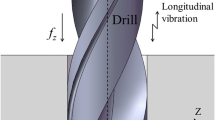Abstract
Vibration drilling technology has the advantages of reliable chip breaking, smooth chip removal, small drilling force, and slight tool wear. However, most of the current vibration drilling devices are special machine tools, or the existing machine tools are transformed. The problems of high cost, poor universality, and difficult parameter adjustment limit the further promotion of vibration drilling technology. Based on the principle of friction transmission, this paper designs a low-frequency axial vibration drilling tool handle with adjustable amplitude and connected with the machine tool by standard connection mode. The design principle of the frequency rotation ratio of the vibration drilling tool handle is obtained, the working principle and amplitude adjustment mode of the tool handle are analyzed, and the theoretical vibration curve of the tool handle is calculated by analyzing the chip-breaking mechanism of vibration drilling. The actual amplitude and axial output characteristics of the tool handle were tested, thereby guiding the further application of vibration drilling.
Similar content being viewed by others
References
A. Rivero et al., An experimental investigation of the effect of coatings and cutting parameters on the dry drilling performance of aluminium alloys, The International Journal of Advanced Manufacturing Technology, 28 (2006) 1–11.
A. Graves, S. Norgren, P. Crawforth and M. Jackson, Surface roughness response to drilling of Ti-5Al-5Mo-5V-3Crusing Ti-Al-N PVD coated and uncoated WC/Co tools, Procedia CIRP, 87 (2020) 170–175.
Y. Bu, G. Xu and Q. Xiao, Automatic precision drilling technology of aircraft structural part, Aeronautical Manufacturing Technology (24) (2009) 61–64 (In Chinese).
A. Ahmed, J. Boban and M. Rahman, Novel EDM deep hole drilling strategy using tubular electrode with orifice, CIRP Annals — Manufacturing Technology, 70 (1) (2021) 151–154.
W. Zhang and S. Wang, Experimental research on multi-objective optimization of TC4 titanium alloy EDM small hole machining, Mechanical Science and Technology for Aerospace Engineering (10) (2021) 1–9 (In Chinese).
M. Zishanur Rahman, A. K. Das and S. Chattopadhyaya, Comparative studies in electro-physical processes (ECM & EDM) for circular micro-holes drilling, Materials Today: Proceedings, 5 (14) (2018) 27690–27699.
H. Gao et al., Composite holes by spiral milling at low stiffness have higher accuracy, Diamond and Abrasives Engineering, 38 (3) (2018) 42–47 (In Chinese).
F. Wang and Y. Wang, Influence of cryogenic cooling on milling hole exit of QFRP based on thermal-mechanical coupling, The International Journal of Advanced Manufacturing Technology, 110 (2020) 1113–1124.
B. Vakili Azghandi et al., An experimental study on cutting forces in ultrasonic assisted drilling, Procedia CIRP, 46 (2016) 563–566.
L. Ren et al., Design of axial vibration device for deep hole processing, Tool Technology, 52 (2) (2018) 103–106 (In Chinese).
L. Zheng et al., Drilling machinability of engineering ceramics under low-frequency axial vibration processing by sintering brazing composite diamond trepanning bit, Ceram Int., 45 (9) (2019) 11905–11911.
F. Zou, J. Dang, Q. An and M. Chen, Mechanism and feasibility study of low frequency vibration assisted drilling of a newly developed CFRP/Al co-cured material, Journal of Manufacturing Processes, 68 (2021) 115–127.
R. Hussein, A. Sadek, M. A. Elbestawi and M. H. Attia, Low-frequency vibration-assisted drilling of hybrid CFRP/Ti6Al4V stacked material, Int. J. Adv. Manuf. Technol., 98 (2018) 2801–2817.
T. Paulsen, O. Pecat, A. Wagner and E. Brinksmeier, Modification of oscillation modes in low frequency vibration drilling, Procedia Manufacturing, 14 (2017) 1–7.
Y. Zhang et al., Review of ultrasonic vibration assisted drilling, Journal of Mechanical Engineering, 53 (19) (2017) 33–44 (In Chinese).
U. Heisel, J. Wallaschek, R. Eisseler and C. Potthast, Ultrasonic deep hole drilling in electrolytic copper Ecu 57, CIRP Annals — Manufacturing Technology, 57 (1) (2008) 53–56.
D. Biermann et al., Deep hole drilling, CIRP Annals Manufacturing Technology, 67 (2) (2018) 673–694.
F. Bleicher et al., Vibration assisted drilling of CFRP/metal stacks at low frequencies and high amplitudes, Production Engineering, 12 (2018) 289–296.
G. Peigne, WO2008000935-Ring-Rolling Bearing with Axial Displacement and Shaping Tooling Equipped with Such a Bearing, PCT/FR2007/001024, WIPO (2007).
M. Ladonne et al., Modelling the vibration-assisted drilling process: identification of influential phenomena, International Journal of Advanced Manufacturing Technology, 81 (2015) 1657–1666.
J. Jallageas and J. Y. K’Nevez, Modeling and optimization of vibration-assisted drilling on positive feed drilling unit, International Journal of Advanced Manufacturing Technology, 67 (2013) 1205–1216.
J. D. Watford et al., Feed Oscillation Via Variable Pitch Gears, PCT/US2016/062178, WIPO (2017).
J. D. Watford and E. A. Harris, Oscillating Thrust Bearing, US20170136591A1, USA Patent (2017).
X. Li et al., Modeling and experimental investigation of drilling force for low-frequency axial vibration-assisted BTA deep hole drilling, The International Journal of Advanced Manufacturing Technology, 111 (2020) 1721–1733.
X. Zhang et al., Analysis of contact strength of asymmetric gear for small diameter turbodrill reducer, Journal of Mechanical Transmission, 44 (7) (2020) 95–101 (In Chinese).
W. Li et al., Reliability evaluation on very high cycle fatigue property of GCr15 bearing steel, International Journal of Fatigue, 32 (7) (2010) 1096–1107.
S. Hou et al., Nonlinear study on low-frequency vibration drilling of Ti6Al4V plate, Journal of Vibration, Measurement and Diagnosis, 41 (2) (2021) 370–376 (In Chinese).
Author information
Authors and Affiliations
Corresponding author
Additional information
Chen Ting is currently studying for a doctorate degree at the Xi’an University of Technology, Xi’an, China. Her research interests include vibration drilling and monitoring of tapping process.
Zheng Jianming is a Professor and doctoral supervisor of Xi’an University of Technology, Xi’an, China. His research interests include vibration drilling, deep hole cutting, and fault diagnosis.
Cao Chao is a master’s degree candidate of Xi’an University of Technology, Xi’an, China. His research direction is vibration drilling.
Rights and permissions
About this article
Cite this article
Chen, T., Zheng, J. & Cao, C. Design and vibration parameter test of low-frequency axial vibration drilling tool handle. J Mech Sci Technol 37, 2527–2535 (2023). https://doi.org/10.1007/s12206-023-0428-3
Received:
Revised:
Accepted:
Published:
Issue Date:
DOI: https://doi.org/10.1007/s12206-023-0428-3




